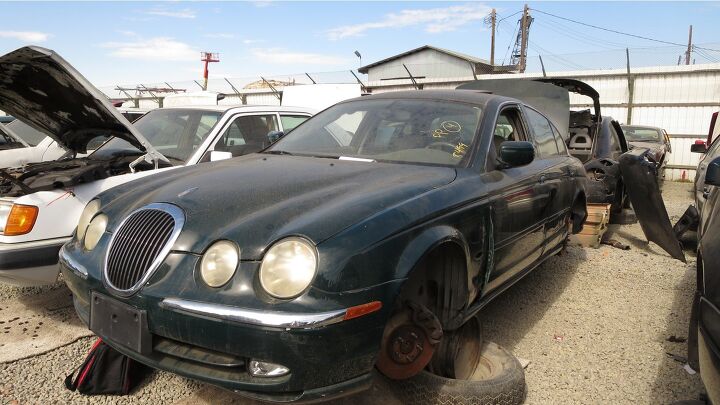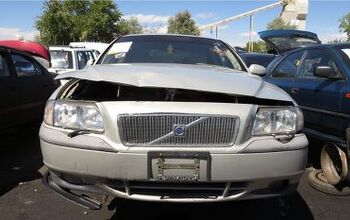Junkyard Find: 2000 Jaguar S-Type

Not long ago, we had a Lincoln LS Junkyard Find, and, of course, that means that we need to take a look at the Jaguar counterpart to this mostly-forgotten Jag-O-Lincoln: the S-Type.
It’s no sweat finding a junkyard S-Type these days, particularly when you look in a high-inventory-turnover San Francisco Bay Area yard, and so here’s a not-very-hooptie example I saw last month.
The front of this car looks quite British, but the rear sure has a lot of ’92 Crown Vic-ness going on.
You could get an S-Type or an LS with a manual transmission in the United States, provided you got the V-6 engine. This 281-horsepower AJ-V8 DOHC engine was connected to a 5-speed Ford automatic.
The leather is worn, but the wood still looks nice. It might be fun to buy a good-running Lincoln LS and swap the S-Type’s interior into it.
Twenty-first-century Jags have endured some rough depreciation. We haven’t had an S-Type in the 24 Hours of LeMons yet, but we just saw our first X-Type a few months ago (it blew up within minutes of the green flag).
The V-8 S-Type listed at $48,000 in 2000, or about 66 grand in inflation-adjusted dollars.
The TV ads were high-buck/quid affairs.

Murilee Martin is the pen name of Phil Greden, a writer who has lived in Minnesota, California, Georgia and (now) Colorado. He has toiled at copywriting, technical writing, junkmail writing, fiction writing and now automotive writing. He has owned many terrible vehicles and some good ones. He spends a great deal of time in self-service junkyards. These days, he writes for publications including Autoweek, Autoblog, Hagerty, The Truth About Cars and Capital One.
More by Murilee Martin
Latest Car Reviews
Read moreLatest Product Reviews
Read moreRecent Comments
- W Conrad I'm not afraid of them, but they aren't needed for everyone or everywhere. Long haul and highway driving sure, but in the city, nope.
- Jalop1991 In a manner similar to PHEV being the correct answer, I declare RPVs to be the correct answer here.We're doing it with certain aircraft; why not with cars on the ground, using hardware and tools like Telsa's "FSD" or GM's "SuperCruise" as the base?Take the local Uber driver out of the car, and put him in a professional centralized environment from where he drives me around. The system and the individual car can have awareness as well as gates, but he's responsible for the driving.Put the tech into my car, and let me buy it as needed. I need someone else to drive me home; hit the button and voila, I've hired a driver for the moment. I don't want to drive 11 hours to my vacation spot; hire the remote pilot for that. When I get there, I have my car and he's still at his normal location, piloting cars for other people.The system would allow for driver rest period, like what's required for truckers, so I might end up with multiple people driving me to the coast. I don't care. And they don't have to be physically with me, therefore they can be way cheaper.Charge taxi-type per-mile rates. For long drives, offer per-trip rates. Offer subscriptions, including miles/hours. Whatever.(And for grins, dress the remote pilots all as Johnnie.)Start this out with big rigs. Take the trucker away from the long haul driving, and let him be there for emergencies and the short haul parts of the trip.And in a manner similar to PHEVs being discredited, I fully expect to be razzed for this brilliant idea (not unlike how Alan Kay wasn't recognized until many many years later for his Dynabook vision).
- B-BodyBuick84 Not afraid of AV's as I highly doubt they will ever be %100 viable for our roads. Stop-and-go downtown city or rush hour highway traffic? I can see that, but otherwise there's simply too many variables. Bad weather conditions, faded road lines or markings, reflective surfaces with glare, etc. There's also the issue of cultural norms. About a decade ago there was actually an online test called 'The Morality Machine' one could do online where you were in control of an AV and choose what action to take when a crash was inevitable. I think something like 2.5 million people across the world participated? For example, do you hit and most likely kill the elderly couple strolling across the crosswalk or crash the vehicle into a cement barrier and almost certainly cause the death of the vehicle occupants? What if it's a parent and child? In N. America 98% of people choose to hit the elderly couple and save themselves while in Asia, the exact opposite happened where 98% choose to hit the parent and child. Why? Cultural differences. Asia puts a lot of emphasis on respecting their elderly while N. America has a culture of 'save/ protect the children'. Are these AV's going to respect that culture? Is a VW Jetta or Buick Envision AV going to have different programming depending on whether it's sold in Canada or Taiwan? how's that going to effect legislation and legal battles when a crash inevitibly does happen? These are the true barriers to mass AV adoption, and in the 10 years since that test came out, there has been zero answers or progress on this matter. So no, I'm not afraid of AV's simply because with the exception of a few specific situations, most avenues are going to prove to be a dead-end for automakers.
- Mike Bradley Autonomous cars were developed in Silicon Valley. For new products there, the standard business plan is to put a barely-functioning product on the market right away and wait for the early-adopter customers to find the flaws. That's exactly what's happened. Detroit's plan is pretty much the opposite, but Detroit isn't developing this product. That's why dealers, for instance, haven't been trained in the cars.
- Dartman https://apnews.com/article/artificial-intelligence-fighter-jets-air-force-6a1100c96a73ca9b7f41cbd6a2753fdaAutonomous/Ai is here now. The question is implementation and acceptance.











































Comments
Join the conversation
Agree I always liked these Jaguars. Drop a small block V-8 GM engine with a GM automatic and these would be a fairly reliable vehicle. A nice fuel injected 350 V-8.
The fun version of this was the S-type R produced in 2002 (for how long, I'm not sure). It had the 4.2 litre V8 with an Eaton supercharger on top, making 400 horses. It felt very fast to me. Lots of brawny power on tap, and very quick to get going. Sometimes I think about finding another one. In 2000, though, I had a loan of an S-type with the normal V8. At the time, it felt pretty grand inside. I gave my in-laws a ride to dinner, and my mother-in-law went out pretty much the next day and bought one. Well, she's still driving it! The reliability issues total two: a wiring glitch re the door lock (easy fix) and a transmission rebuild (not cheap). Otherwise all solid. I drove it once a year or two ago and it had lost a lot of the glam and grandness. But it felt good, just the same, to pilot it around. That damnedJaguar hood ornament still helps.